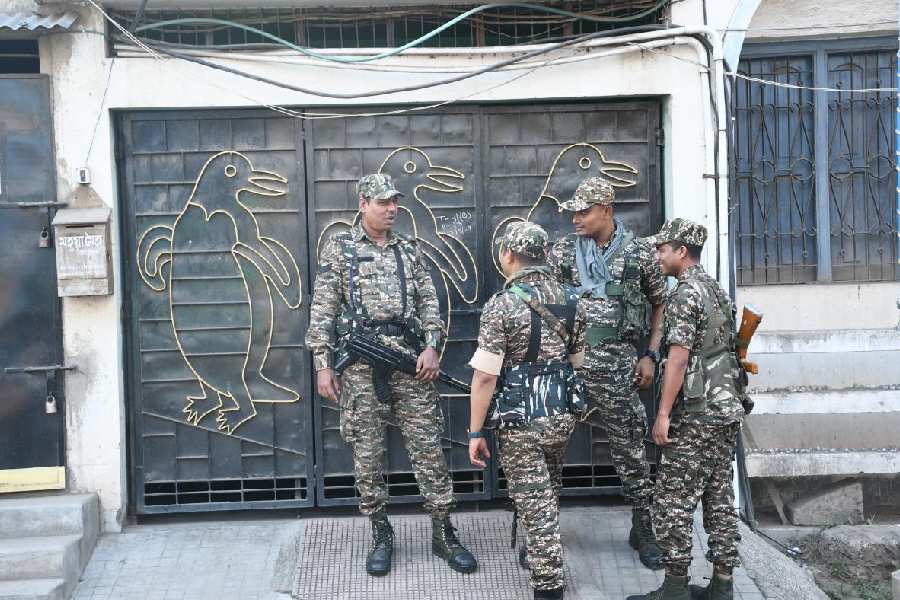For over three months since her expulsion from the Lok Sabha, Trinamul's Mahua Moitra has dug her heels in Nadia as she criss-crossed the district between her local residence at Karimpur and her constituency Krishnagar to secure a second-term in Parliament.
Her return to the next Lok Sabha, however, depends on the way she negotiates the on-ground intricacies of the hustings, ie, amidst the voters. Outside the constituency, Moitra has been fighting many battles, political and personal, and the ones where the two overlap.
Saturday was one such day.
Early in the morning, officers from the Central Bureau of Investigation knocked at a ninth floor flat, linked to the expelled MP, in "Ratnabali, a highrise in South Calcutta’s Alipore area, in connection with a cash-for-query charge levelled against her by a BJP MP that led to her expulsion from Parliament. Later in the day, another team from the central probe agency was at her office in Krishnagar’s high street Siddheswari Kalibari area.
The raid came two days after the CBI lodged an FIR against her, following the nod from the anti-corruption ombudsman Lokpal, on the corruption charge. She has challenged the decision to expel her in the Supreme Court.
Many believe the expulsion gave the feisty former MP a fresh lease of life and guaranteed her nomination which was confirmed by the Bengal chief minister and her boss, Mamata Banerjee, at the Brigade Parade Ground about a fortnight ago. The raids on Saturday, coming soon after the arrest of Delhi chief minister Arvind Kejriwal, can only bolster her image as an opponent of Narendra Modi in the run up to the Lok Sabha polls.
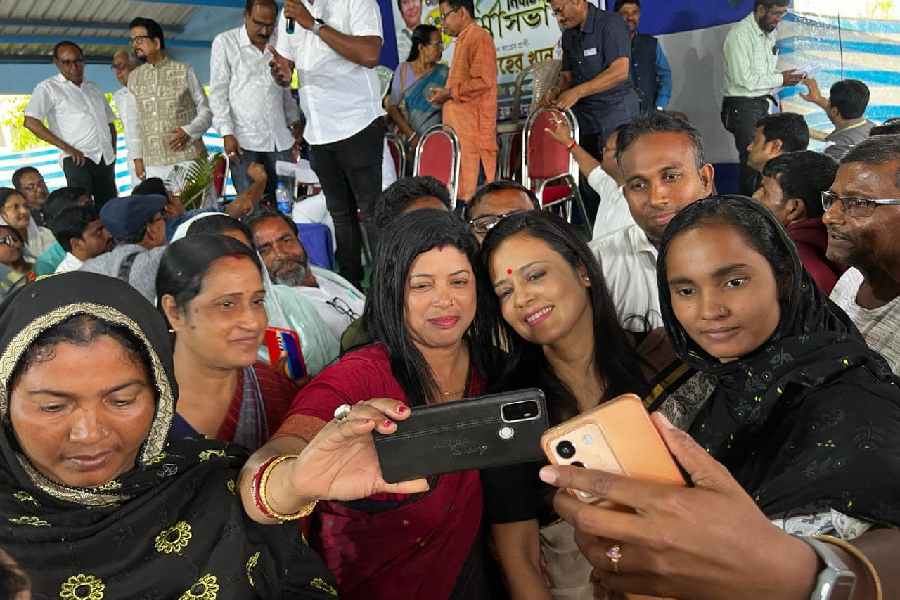
Moitra With party workers in Nadia during poll campaigning Facebook/MahuaMoitra
Everyone who knows Moitra, or has come to know her in the 15 years since she stepped into politics, knows she loves to maintain a distance. She calls herself the “disobedient woman” rendered “radioactive” by the Hindu nationalist BJP leaving her without friends, but she keeps reminding her adversaries in the BJP and those in her own party rank and file that she is not going anywhere.
In the New India propagated by the ruling BJP, Moitra does not tick any of the boxes. She is good-looking, smart, aggressive, articulate, unapologetically forthright, independent-minded and a divorcee. Most important, she is not afraid of asking questions.
Born into an upper caste Hindu family, with a liberal progressive upbringing that not only helped her professional career as a banker but also shaped her world-view and politics, she often finds herself in natural conflict with a set of men who are misogynistic and/or narrow-minded, part of the ecosystem that is trying to build an India of its own imagination.
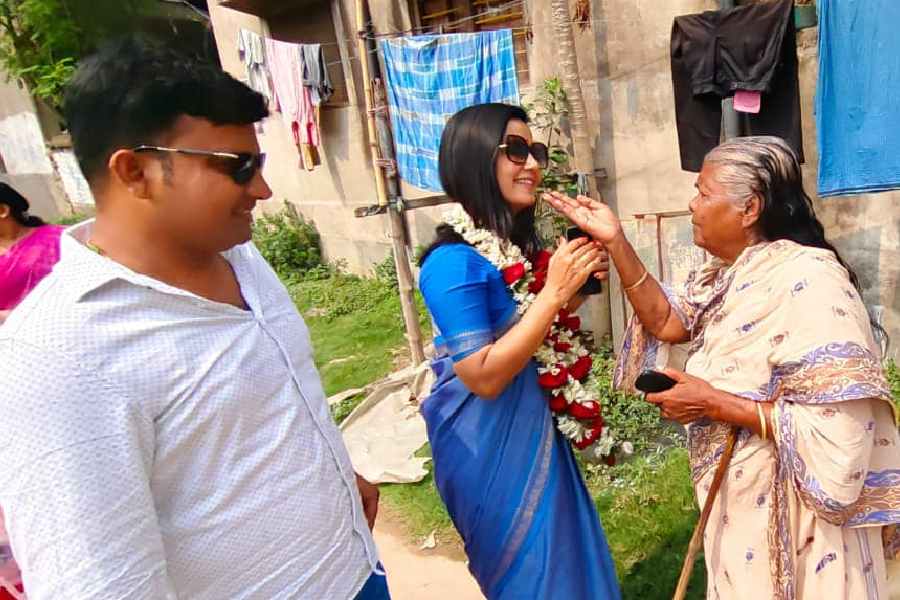
With a voter in Krishnagar Facebook/MahuaMoitra
Walking out of the boardroom
About a decade and-a-half ago, Moitra said goodbye to first world corporate boardrooms and entered Indian politics as a rookie “sipahi” under Rahul Gandhi, though those who knew her then say, she has always been more of a general adept at giving orders.
Around the same time another former banker, the late Meera Sanyal (born into a Sindhi family in then Bombay), 13 years senior to Moitra, took the plunge into politics. In 1984, when Sanyal started her career in banking as an officer in Calcutta’s ANZ Grindlay’s, Moitra was barely 10-years old. We don’t know if their paths had ever crossed later in life.
When they chose to join public life, the two women shared similar, though somewhat vague notions of change that they wanted to bring into the world and a love for sarees. Had tony South Mumbai voted for Sanyal in 2009 when she contested as an Independent (or again five years later when she fought as an Aam Aadmi Party nominee), Moitra might have come across a political soulmate.
Had the Congress high command and Mamata Banerjee agreed to the Bengal Congress’ demand to leave the Krishnagar seat for the grand old party, Moitra (whose name was recommended) might have made her parliamentary debut in 2009. But, to her credit, Moitra did not take umbrage at having denied the election ticket. Rather, she devoted herself to the cause of the alliance.
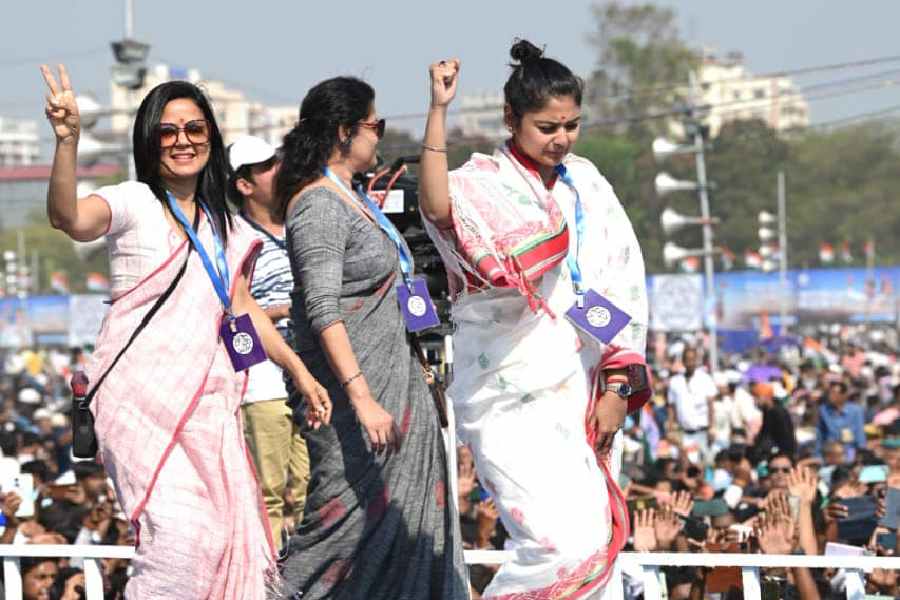
Walking the ramp at the Brigade Parade ground after her name was announced as candidate from Krishnagar, with TMC youth president Saayoni Ghosh Facebook/MahuaMoitra
Moitra had to wait exactly a decade to make her debut in Parliament. Sanyal, who the SoBo political establishment mocked as the “Malabar Hill Memsahib”, died in January 2019 and never made it.
In 2008, barely months into politics, Moitra had said in an interview, that it was her duty to do something and she was doing it. It would take her another 11 years to find that “doing” in New Delhi.
Hard working and meticulous
Hard working is how the Bengal Congress’s Amitabha Chakraborty, then secretary of the state unit of the Youth Congress handling the “Aam Aadmi ka Sipahi” programme in the state, describes her as. “I received a call from Rahul Gandhi’s office, informing about one Mahua Moitra. I did not know anything about her. I was instructed to give her some responsibility,” says Chakraborty. “She did a lot of work then at the grassroots level. Her departure was a loss.”
The jump to the Trinamul Congress did not automatically open doors for Moitra. In the year of “Poriborton (change)”, Moitra was dropped from the list of candidates, after she voiced her reservations about the Murshidabad constituency she was nominated from. Within the Trinamul that small act of rebellion was political hara-kiri, especially for a newcomer. Post-2011, as the Trinamul settled into governance mode, Moitra remained on the horizons. Neither faded, but not quite there yet.
Five years later, when her name was announced from Nadia’s Karimpur Assembly constituency. Moitra did not make any noises. Not even the correct ones.
A leader takes shape
Moitra found her true calling only after she moved to Delhi as a first-time MP in 2019 and went after the Narendra Modi government over its crushing of constitutional institutions, control over the media, hounding of Opposition leaders with central probe agencies, alleged persecution of minorities, dalits and women.
The more Moitra spoke in Parliament, the more her videos went viral and her appeal grew among the set of people derisively mocked by Modi himself as the Khan Market gang, a reference to the U-shaped double-storey shopping complex where New Delhi’s elite gather to share political gossip over a cuppa.
Her appeal, via social media, is not restricted to the physical confines of the neighbourhood in Lutyen’s Delhi. It is also representative of a mindset that opposes the Hindutva vision of India. Female historians, academics, writers, actors – with varying degrees of fame --- trolled, slut-shamed, body-shamed, dog whistled at for holding up an opinion that runs contrary to the narrative peddled by New Delhi’s ruling dispensation, would prefer to have Moitra as their voice in the Lok Sabha.
Civil Rights activist Teesta Setalvad says that though she has never met Moitra, she admires her sense of “political commitment, courage and articulation.”
“The Indian male is a curious creature. Acculturated to worshipping powerful female deities but threatened with autonomous and clear voices in the public sphere. Yet he or the wider public appears to accept an aggressive hate driven voice emanating from H-pop singers or godwomen. A sane, secular, principled voice from a woman like Mahua Moitra threatens the perilous structure of a majoritarian theocratic state that is sought to be built,” says Setalvad.
On the battle turf
Moitra is confident that she will return to the Lok Sabha post the general elections this year. What she cannot be confident of is the absolute allegiance of the legislators in the seven Assembly segments that make the Krishnagar Lok Sabha seat.
If the grapevine is to be believed, even as she fumed against the Narendra Modi government in Delhi, she was on a sticky within the party till her expulsion. The events that unfolded soon after her expulsion in the Parliament took the focus off her, allowing her the space for course correction.
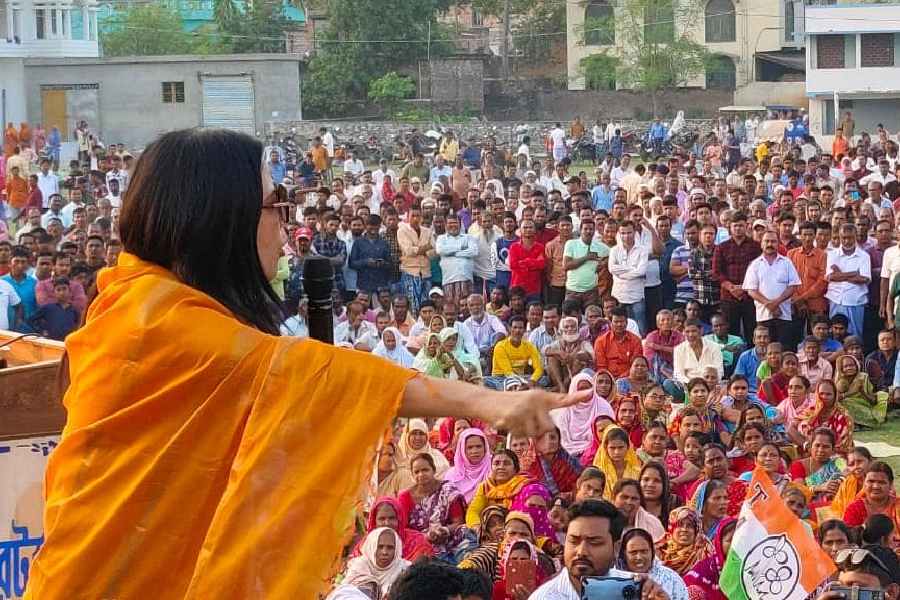
From the boardroom to the ground Facebook/MahuaMoitra
From 2019, while her stature grew nationally, she cut a lone figure on the home turf. She was perceived to be neither close to Mamata nor her heir-apparent Abhishek Banerjee. Yet, her’s was the most significant voice against the Modi government from within the Trinamul, a factor that the Trinamul top brass could not ignore. That anti-Modi perception is crucial for Mamata as she prepares for the 2024 general elections. Moitra’s is such a strong voice that even bitter rivals in Bengal, the Congress and the CPM, spoke in her favour much before her own party did.
On the micro-blogging site X (previously known as Twitter), Moitra follows only three accounts: the party’s official handle, the party’s chief, Mamata Banerjee and has recently added Abhishek to the list.
In October last year, before the cash-for-query controversy exploded on her face, Moitra joined Abhishek during his sit-ins in New Delhi and Calcutta. In Delhi, cops forcibly dragged her out of the protest. It was all over television. And soon after Abhishek spoke in support with the rider that “she was capable of fighting on her own.”
While no Trinamul leader will come on record, in private most, including her former Lok Sabha colleagues, find her “ambitious” and “domineering”, the same labels that the BJP has used to attack her with in the last three years. “She should have been sent packing long ago, why do we have to protest for her?” a Trinamul Lok Sabha MP from south Bengal had apparently commented moments after her expulsion.
A possible turnaround
Now, when she is in her former Parliamentary constituency of Krishnagar, Moitra has made a concerted effort to work together with the MLAs whose support she needs to make it through this time. She has focussed on the Assembly segments of Chapra, Kaligunj and Nakashipara, holding multiple meetings with the local leaderships, though many feel she hasn’t changed her ways.
“She takes decisions arbitrarily and without consultations,” says a local leader.
In the 2019 Lok Sabha polls, Chapra gave Moitra a lead of 49,000 votes. A lead that could prove valuable once again. The BJP is yet to announce its candidate for the seat, which it had won in the past, though the scales are heavily tilted in favour of a member of the Krishnagar royal family. The CPM has announced the former Palashipara legislator S.M. Sadi as its nominee.
The Krishnagar seat is heavily polarised with Hindus, across caste barriers leaning towards the BJP, while the Trinamul is banking heavily on the 36.3 per cent Muslim voters mainly in Chapra, Kaligunj, Nakashipara and partly Tehatta to vote en-bloc for the party as they had done in the past. If the CPM’s Sadi can make a dent in the Muslim votes that would make things tougher for Moitra. In last year’s panchayat polls, the CPM’s vote share was around 21 per cent.
Krishnagar will vote on May 13


